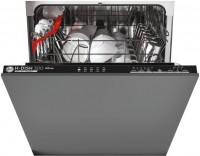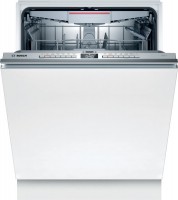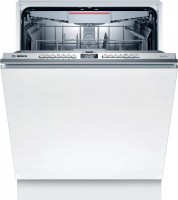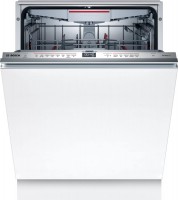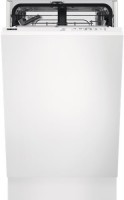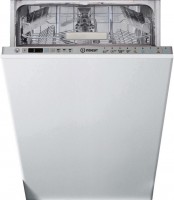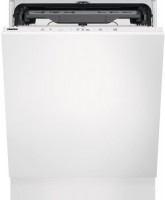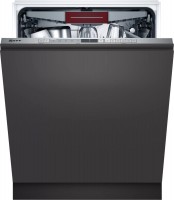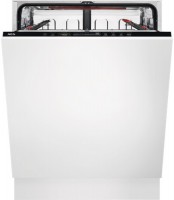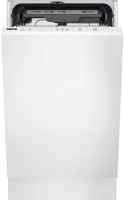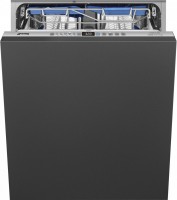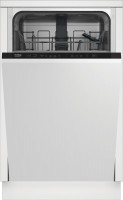Integrated Dishwashers Bosch
All Dishwashers Advanced filters → |
You might be interested in
Articles, reviews, useful tips
All materials
How to choose a dishwasher
Key points when choosing a dishwasher

Five great built-in dishwashers with an open control panel
The visible part of the design of such dishwashers is only the control panel

How to properly use a dishwasher
Compliance with simple operating rules is a direct way to prolong the life of a dishwasher

How to maintain and clean the dishwasher
A set of preventive measures to keep the dishwasher in perfect condition

Energy label reform: new gradations of energy efficiency classes for household appliances
Rethinking energy efficiency classes and returning to the historical gradation "from A to G"

The best built-in dishwashers 60 cm with hot water connection
Functional dishwashers that can be connected to hot water
Integrated Dishwashers: specifications, types
Show all
Type of instalation
— Fully integrated -in. Fully integrated dishwashers are devices in which, with the door closed, the control panel is hidden inside. The controls are usually mounted on the top end of the door for this. The main advantage of such devices is a neat appearance: in the closed position, only a solid door is outside (on which sometimes there is even no handle, see “Opening without a handle”). Another thing is that the control panel is less prone to contamination. At the same time, you inevitably have to open the machine to access it; this can create inconvenience if the programme needs to be changed right in the process of work. The indicators are also hidden inside; this disadvantage can be partly corrected by the “beam on the floor” system (see the relevant paragraph), but it is not available in all such models.
— With an open control panel. Dishwashers in which the control panel is located outside, above the door. Thanks to this, the user has constant access to the controls, and to the display and other indicators; in this sense, such units are noticeably more convenient than fully integrated ones. Their disadvantage is primarily related to the design: the control panel will not fit into every kitchen interior, especially if the owner of the kitchen appreciates minimalism and the absence of unnecessary details on the kitchen set.
— With an open control panel. Dishwashers in which the control panel is located outside, above the door. Thanks to this, the user has constant access to the controls, and to the display and other indicators; in this sense, such units are noticeably more convenient than fully integrated ones. Their disadvantage is primarily related to the design: the control panel will not fit into every kitchen interior, especially if the owner of the kitchen appreciates minimalism and the absence of unnecessary details on the kitchen set.
Number of place settings
The maximum number of dish sets that can be loaded into the dishwasher at one time. A set is considered a set of dishes for one person: four plates (for the first course, for the second course, salad, bread), a plate for dessert, a cup, a spoon and a fork.
The large capacity allows you to wash numerous dishes in the device at one time without starting the washing programme again. At the same time, excess capacity is just as undesirable as insufficient. Firstly, a capacious operating chamber affects the dimensions of the entire device. Secondly, such units consume more water. Thirdly, if there is not much dirty dishes, you either have to wait until it accumulates, or start an underloaded device, wasting water and detergents. Therefore, when choosing according to this indicator, real needs must be taken into account and not chase after the maximum capacity.
The large capacity allows you to wash numerous dishes in the device at one time without starting the washing programme again. At the same time, excess capacity is just as undesirable as insufficient. Firstly, a capacious operating chamber affects the dimensions of the entire device. Secondly, such units consume more water. Thirdly, if there is not much dirty dishes, you either have to wait until it accumulates, or start an underloaded device, wasting water and detergents. Therefore, when choosing according to this indicator, real needs must be taken into account and not chase after the maximum capacity.
Water consumption
The amount of water used by the dishwasher in one washing cycle. Usually, it is indicated for a standard cycle — at full load, without pre-rinsing, etc. Accordingly, in special modes, the consumption may differ from the indicated one.
The lower the consumption — it better; this is especially true for those who consume water by metres or who have a limited supply of water (for example, it is drawn from a well with a low productivity). On the other hand, a reduction in consumption can have a negative effect on the quality of the wash. So, choosing an economical dishwasher, you should pay attention to the washing class (see below). In addition, only models of the same capacity can be compared in terms of consumption — after all, the more dishes, the more water is required to wash them.
The lower the consumption — it better; this is especially true for those who consume water by metres or who have a limited supply of water (for example, it is drawn from a well with a low productivity). On the other hand, a reduction in consumption can have a negative effect on the quality of the wash. So, choosing an economical dishwasher, you should pay attention to the washing class (see below). In addition, only models of the same capacity can be compared in terms of consumption — after all, the more dishes, the more water is required to wash them.
Dryer type
The dishwasher has a drying function. Drying can occur both due to the natural evaporation of water from the surface of the dishes (condensation drying), and due to its blowing with heated air; the first option is more economical, since it does not require energy and there is also an improved one — with a heat exchanger; the second, in turn, provides faster drying. The recently introduced new type of Zeolith drying combines two methods, as it first collects residual moisture and then converts it into heat, which dries the dishes and belongs to premium segment models. Note that not all dishwashers are capable of drying dishes to dryness; see drying class for details.
Auto door opening
Auto door opening at the end of the programme. This function not only provides additional convenience, but also plays the role of a signal about the end of work; in addition, the open door helps to speed up drying — excess moisture escapes through it.
Cutlery tray
Separate cutlery tray for loading (spoons, forks, knives, etc.) into the dishwasher. Such a device is more convenient than a common basket: it allows you to load cutlery separately from the rest of the dishes, while the contents of the tray are compactly located in the “seats” specially designed for this. And the quality of washing is often higher than when using a common basket.
Inverter motor
The presence of an inverter motor in the design of the dishwasher.
Inverter motors are brushless and have higher efficiency, lower noise levels, and improved safety due to the absence of brushes. However, they are more expensive compared to conventional motors.
Inverter motors are brushless and have higher efficiency, lower noise levels, and improved safety due to the absence of brushes. However, they are more expensive compared to conventional motors.
Energy class (new)
This parameter characterizes the efficiency of electricity consumption by a dishwasher. Classes are denotet in Latin letters from A to G, in ascending order of energy consumption. Actually, more energy-efficient models have not been added to the A class, which eventually received the marking A +, A ++, A +++. Further development of technology has made it possible to go even further, and in order not to produce pluses in energy efficiency marking, manufacturers returned to the previous indices from G to A in March 2021, where А is the most energy efficient dishwasher. But also class B, C, D and even E are also quite economical (no worse than A +++). Accordingly, the 2021 models will have modern markings, while older models will be marked in the same way.
Energy class
The energy efficiency class characterizes the the economy of a dishwasher's electricity consumption. Initially, the classes were denoted in Latin letters from A (high degree of economy) to G (high consumption). But later, with the development of energy saving technologies, more advanced classes than A appeared. They are denoted by the letter A with a certain number of pluses (A+, A++, etc.); the more benefits, the higher the economy. Most modern built-in dishwashers comply with energy classes from A to A+++(the last is 30% more economical than the original class A). More high consumption models, such as classes B and C, are much rarer and gradually disappear.
More economical models cost more, but the difference can be recouped in energy savings. Also note that the energy consumption class does not describe efficiency in general, but in comparison with other similar models; therefore, the actual consumption of a small class A device may be lower than that of a large class A++ model.
More economical models cost more, but the difference can be recouped in energy savings. Also note that the energy consumption class does not describe efficiency in general, but in comparison with other similar models; therefore, the actual consumption of a small class A device may be lower than that of a large class A++ model.
Noise level
The approximate noise level produced by the dishwasher during operation. In modern models, this parameter can range from 37 – 39 dB (muffled human voice) to 59 – 60 dB (loud conversation); more detailed decoding of what sound corresponds to a particular number of decibels can be found in special tables. Anyway, the low noise level contributes to the comfortable use of the device. It is especially important if the dishwasher is to be used at night (for example, if there are reduced electricity rates at night).
Noise class
Allows people to decode the values of the noise level in decibels. It is marked in Latin letters like other classes, where A is the quietest class of dishwashers.
Number of programmes
The number of washing programs (modes) provided in the dishwasher. These programs may differ in duration, exposure intensity, water temperature, dish material (for example for delicate dishes), etc. For more information on the different options, see "Washing programs". And the more modes — the more advanced the device is, the more options it provides to choose from. But note that with the same number of programs, their specific set in different models may be different; these details should be clarified separately.
Washing modes
— Own programme. Possibility to create and save a custom programme by setting the parameters to your liking. This function is convenient because instead of setting the washing settings manually each time, it is enough to save them once in the device’s memory and then simply select a user programme from the list.
— Half load. A special programme for cases when the dishwasher is loaded with only half of its regular capacity. Running a full-fledged wash in such cases would be too wasteful; so in the half load mode, the dishwasher reduces the consumption of water, detergents and electricity, focus on a reduced amount of dishes. Such a programme is relevant mainly for roomy models (from 8 sets).
— Pre-rinsing. The "soaking" mode is a program that rinses dishes with cold water and keeps them from drying for a long time, preventing food residues from sticking to the plates. It's useful for storing unwashed dishes for a long time, and for washing heavily soiled dishes without using intensive washing programs.
— Quick wash. A quick wash programme that saves time. Designed mainly for lightly soiled dishes that do not require particularly intensive exposure; for cope with serious pollution is not suitable.
— Automatic. This program allows the dishwasher to monitor the washing proc...ess using sensors that evaluate the water composition during rinsing. The washing process ends when the water is free of impurities, ensuring optimal resource consumption. The washing mode varies by model, with some offering only standard automatic programs and others allowing users to choose the water temperature.
— Economical. A programme that reduces the consumption of water, detergents and electricity compared to a normal washing cycle. Usually, it is intended for dishes without heavy soiling and dried food residues, although individual models may have their own features of the economy mode.
— Delicate (for glass). Special programme for washing delicate dishes, especially that are made of thin glass (goblets, wine glasses, etc.). Washing is carried out at low temperatures (to avoid drops) and with minimal mechanical actions, which allows you to keep delicate dishes intact.
— Hygienic. This program is designed to destroy pathogenic bacteria and viruses effectively. It uses elevated water temperatures (around 68...70°C) that can provide a bactericidal effect without special detergents. This mode is useful for washing children's dishes and can be helpful when someone in the family is sick.
— Intensive. Special programme for washing heavily soiled dishes, such as pans with dried-on food residues. Usually, it provides increased pressure and elevated water temperature.
— Night(quiet). This program is designed for use at night or in situations where excessive noise is undesirable. It reduces the noise produced by the dishwasher by decreasing water temperature, pressure, and using other techniques depending on the model. The necessary washing efficiency is maintained by increasing the operating time, making it suitable for use at night.
— Steam treatment. Hot steam treatment can be used to soften dried food residues and sterilize jars and utensils for home canning. The process consumes a lot of energy.
In addition to the above, other types of programs may be indicated in the specs of dishwashers, in particular:
— Normal. Standard programme for washing lightly soiled dishes with a full load at temperatures around 65 °C. Available in almost all modern dishwashers, but sometimes manufacturers specify its availability separately.
— Plastic utensils. The programme is designed for washing reusable plastic dishes at lower temperatures and intensity than the standard programme to avoid scratches and damage caused by high heat. Not all plastic dishes are compatible with dishwashers, so compatibility should be checked separately. Washing disposable dishes is not recommended.
— Mixed. This category includes all programs that combine several washing modes at once — for example, the normal mode in the compartment for cups and glasses, and the intensive one in the lower part, where you can put a pot or frying pan. Options for such combinations may be different, depending on the model.
— Self-cleaning. Special programme to remove deposits and disinfect the dishwasher. Self-cleaning mode heats water with detergents to remove moderate pollution, and can be run multiple times for tough deposits.
— Half load. A special programme for cases when the dishwasher is loaded with only half of its regular capacity. Running a full-fledged wash in such cases would be too wasteful; so in the half load mode, the dishwasher reduces the consumption of water, detergents and electricity, focus on a reduced amount of dishes. Such a programme is relevant mainly for roomy models (from 8 sets).
— Pre-rinsing. The "soaking" mode is a program that rinses dishes with cold water and keeps them from drying for a long time, preventing food residues from sticking to the plates. It's useful for storing unwashed dishes for a long time, and for washing heavily soiled dishes without using intensive washing programs.
— Quick wash. A quick wash programme that saves time. Designed mainly for lightly soiled dishes that do not require particularly intensive exposure; for cope with serious pollution is not suitable.
— Automatic. This program allows the dishwasher to monitor the washing proc...ess using sensors that evaluate the water composition during rinsing. The washing process ends when the water is free of impurities, ensuring optimal resource consumption. The washing mode varies by model, with some offering only standard automatic programs and others allowing users to choose the water temperature.
— Economical. A programme that reduces the consumption of water, detergents and electricity compared to a normal washing cycle. Usually, it is intended for dishes without heavy soiling and dried food residues, although individual models may have their own features of the economy mode.
— Delicate (for glass). Special programme for washing delicate dishes, especially that are made of thin glass (goblets, wine glasses, etc.). Washing is carried out at low temperatures (to avoid drops) and with minimal mechanical actions, which allows you to keep delicate dishes intact.
— Hygienic. This program is designed to destroy pathogenic bacteria and viruses effectively. It uses elevated water temperatures (around 68...70°C) that can provide a bactericidal effect without special detergents. This mode is useful for washing children's dishes and can be helpful when someone in the family is sick.
— Intensive. Special programme for washing heavily soiled dishes, such as pans with dried-on food residues. Usually, it provides increased pressure and elevated water temperature.
— Night(quiet). This program is designed for use at night or in situations where excessive noise is undesirable. It reduces the noise produced by the dishwasher by decreasing water temperature, pressure, and using other techniques depending on the model. The necessary washing efficiency is maintained by increasing the operating time, making it suitable for use at night.
— Steam treatment. Hot steam treatment can be used to soften dried food residues and sterilize jars and utensils for home canning. The process consumes a lot of energy.
In addition to the above, other types of programs may be indicated in the specs of dishwashers, in particular:
— Normal. Standard programme for washing lightly soiled dishes with a full load at temperatures around 65 °C. Available in almost all modern dishwashers, but sometimes manufacturers specify its availability separately.
— Plastic utensils. The programme is designed for washing reusable plastic dishes at lower temperatures and intensity than the standard programme to avoid scratches and damage caused by high heat. Not all plastic dishes are compatible with dishwashers, so compatibility should be checked separately. Washing disposable dishes is not recommended.
— Mixed. This category includes all programs that combine several washing modes at once — for example, the normal mode in the compartment for cups and glasses, and the intensive one in the lower part, where you can put a pot or frying pan. Options for such combinations may be different, depending on the model.
— Self-cleaning. Special programme to remove deposits and disinfect the dishwasher. Self-cleaning mode heats water with detergents to remove moderate pollution, and can be run multiple times for tough deposits.
Ultraviolet disinfection
Ultraviolet disinfection is one of the most effective and safest methods of antibacterial treatment. The process of irradiation with UV light usually starts after the end of the main dishwashing cycle. The ultraviolet lamp in the working chamber of the machine is responsible for the operation of the function. UV radiation effectively destroys bacteria, viruses and pathogens without forming harmful substances and without resorting to the use of aggressive “chemistry”. The ultraviolet lamp works when the door is closed, making it completely safe for people. The disadvantage of this function is the rather high cost - UV disinfection is found only in advanced models of dishwashers.
Additional nozzles
Availability of additional nozzles, which can be integrated into different areas of the dishwasher's working chamber to improve the ability to effectively wash dishes. Most often, such nozzles refer to additional nozzles for spraying water jets at the bottom of the machine’s chamber. They deliver strong pressure to easily deal with stubborn and stubborn dirt deposits on pots, pans and other large utensils. However, additional nozzles can also be found in the area of the upper basket of the dishwasher, and they are intended for thorough cleaning of glasses, bottles and other similar utensils.
3-in-1 tablets use
The possibility of using "tablets" in the dishwasher — special charges containing all the products necessary for work (detergent, salt for water softening, rinse aid). Without this function, such products have to be loaded into the dishwasher separately, and this is not very convenient.
Delayed start timer
A timer that automatically starts the dishwasher at the user's set time, eliminating the need to do it manually. This function is useful, for example, if the electricity tariffs during the day and at night are different — by setting the start of washing at night, you can save on electricity bills.
End-of-cycle signal
Sound signal, indicating the end of the dishwasher operating. Many dishwashers work quietly and without a special signal, it can be difficult to determine whether the programme has ended.
Beam on floor
The light indicator of work of the dishwasher. During the operation of the device, a special light mark is projected onto the floor in front of it; at the end of the programme, this mark goes out. Thus, one glance in the direction of the device is enough to determine its current state. And for fully integrated models (see "Type of installation"), this function is also convenient because it is no need to open the door to check the status of the device. Actually, the vast majority of units with a "beam on the floor" are fully integrated.
Also note that in high-end dishwashers, not just a light mark in the form of a dot can be used, but a miniature projector, which is a beam on the floor with a time indication or with other auxiliary information.
Also note that in high-end dishwashers, not just a light mark in the form of a dot can be used, but a miniature projector, which is a beam on the floor with a time indication or with other auxiliary information.
Salt indicator
Indicator showing the amount of special salt left in the dishwasher. Such salt is used to soften hard water, it is consumed as the appliance operates; if there is an indicator, it is much easier for the user to monitor the remainder. At the same time, the capabilities of the indicator may be different: in some models, it only signals that the salt is coming to an end, in others — it allows you to more or less accurately determine the remainder.
Rinse aid indicator
The indicator signaling the remainder of the rinse aid — a special product used during rinsing dishes. The specific way this indicator works may be different: in some models, it only signals that the rinse aid is almost empty, while in others, the rinse aid indicator more or less accurately displays the remainder. However, this function makes life easier for the user, allowing you to control accurately the amount of rinse aid.
Leak protection
Automatic system that controls the safe use of water by the dishwasher. In the event of a leak, the water supply is blocked, and collected water is drained, which prevents the “flood” in the house. Leak protection can be applied to the body, to the water supply hoses, or to both (full protection). It is worth noting that hoses with leak protection can usually be purchased and installed separately if the device is not designed with any protection, or it only touches the body.
Hot water supply
Possibility of connection of the dishwasher to a source of hot water. With this connection, the water enters the device already heated (unlike the usual procedure, when the dishwasher itself heats the water to the desired temperature) — thus it saves time and energy. However, note that "hot connection" is demanding on the quality of water: in most cases, it must have a temperature of 60-65 °C and be supplied without pressure drops.
Note that hot water connection is an option, not the only way; dishwashers with the possibility of such a connection can usually work according to the standard scheme, from a source of cold water.
Note that hot water connection is an option, not the only way; dishwashers with the possibility of such a connection can usually work according to the standard scheme, from a source of cold water.
Chamber lighting
The presence of a lighting system in the working chamber of the dishwasher.
Modern dishwashers have deep working chambers which can make it difficult to see the contents, even when the machine is installed in a brightly lit place. A proprietary lighting system solves this problem by improving visibility and doesn't depend on external light sources.
Modern dishwashers have deep working chambers which can make it difficult to see the contents, even when the machine is installed in a brightly lit place. A proprietary lighting system solves this problem by improving visibility and doesn't depend on external light sources.
Bottom basket lift
A special mechanism that allows you to raise the lower basket of the dishwasher. This feature greatly facilitates the loading and unloading of dishes: it is easier to reach the raised basket than the “recessed” one in the working position.
Upper basket adjustment
The ability to adjust the height at which the top basket of the dishwasher is located. This adjustment allows you to adjust the device to the height of the dishes: for example, by moving the basket down, you can load large items into it, such as pots or pans.
Door closer
The presence of an door closer in the design of the dishwasher.
An auto-closer is a device that helps close or open a door smoothly to the fully closed or open position, preventing the door from remaining in an intermediate position. It has two functions: ensuring the door is fully closed to prevent splashes and damage, and providing soft closing/opening to prevent shock and damage.
An auto-closer is a device that helps close or open a door smoothly to the fully closed or open position, preventing the door from remaining in an intermediate position. It has two functions: ensuring the door is fully closed to prevent splashes and damage, and providing soft closing/opening to prevent shock and damage.
Handleless door
Dishwashers equipped with doors without any handles. Accordingly, the method of opening such units differs from the usual one: for example, in some models you need to press on the top of the door, in others you need to knock, activating the automatic mechanism, etc.
This feature does not affect the main functionality of the device, but it can be very appropriate from a design point of view: for example, dishwashers with handleless doors are perfect for kitchens in a minimalist “high-tech” design.
This feature does not affect the main functionality of the device, but it can be very appropriate from a design point of view: for example, dishwashers with handleless doors are perfect for kitchens in a minimalist “high-tech” design.
Sliding hinge
Sliding fastening involves connecting the decorative facade to the dishwasher door by means of movable guides. During the opening of the door, the facade “slides” along the sliders, rising a little up, and when it is closed — it drops lower and becomes flush with the adjacent cabinet doors of the kitchen set. A sliding fastening is used to enable the dishwasher to be built into a column and in order not to cut out the plinth to open the facade.
Controls
— Rotary switch. Rotary switch control. Usually, it is not the only one control: the rotary knob is used to select the operating mode, and the remaining functions of the dishwasher (start-stop programs, timers, etc.) are controlled by buttons. However, panels with rotary switches still have their own specifics, so they are distinguished as a separate type of control. Technically, this option can be used in dishwashers of all price categories, but for a number of reasons, it is found mainly in inexpensive models.
— Push-buttons. Controlled by classic mechanical buttons. This option allows you to work even with the very advanced and extensive functionality that is typical for premium dishwashers, while the buttons are cheaper than the touch panels (see below). Therefore, push-button control can be found in all classes of dishwashers, from low-cost to top-end ones. Its main disadvantage is the presence of slots between the buttons and the panel in comparison with the same sensors, where dirt can clog and cleaning out it can be quite difficult.
— Touch. Control systems with sensors. These controls are easier to operate than simple buttons (see above) — instead of pressing, a light touch is enough. All sensors can be made under the same plane, which makes it easier to clean the control panel and reduces the number of places where dirt can clog. Do not forget t...hat such control gives the dishwasher a modern and advanced look. On the other hand, sensors are more expensive than other types of control, and therefore are used mainly in high-end models.
— Push-buttons. Controlled by classic mechanical buttons. This option allows you to work even with the very advanced and extensive functionality that is typical for premium dishwashers, while the buttons are cheaper than the touch panels (see below). Therefore, push-button control can be found in all classes of dishwashers, from low-cost to top-end ones. Its main disadvantage is the presence of slots between the buttons and the panel in comparison with the same sensors, where dirt can clog and cleaning out it can be quite difficult.
— Touch. Control systems with sensors. These controls are easier to operate than simple buttons (see above) — instead of pressing, a light touch is enough. All sensors can be made under the same plane, which makes it easier to clean the control panel and reduces the number of places where dirt can clog. Do not forget t...hat such control gives the dishwasher a modern and advanced look. On the other hand, sensors are more expensive than other types of control, and therefore are used mainly in high-end models.
Control via Internet
Ability to control the dishwasher via the Internet. Thanks to this feature, the owner can control the device from almost anywhere in the world. In addition, most of these "smart" dishwashers are also capable of sending various notifications — for example, about the end of the programme, the remaining detergent and other consumables, interruptions in the water supply, their own problems, etc. Connecting the dishwasher to the Internet can be done in different ways, but the most commonly used module is Wi-Fi.
The specific features of Internet control may vary. For example, in some models it is carried out through a smartphone, tablet or other gadget with a special application, in others you can use any Internet browser; and the set of dishwasher functions available to the user can also be different. However, this feature provides additional convenience anyway and can be very useful — especially for those who spend most of their time away from home.
The specific features of Internet control may vary. For example, in some models it is carried out through a smartphone, tablet or other gadget with a special application, in others you can use any Internet browser; and the set of dishwasher functions available to the user can also be different. However, this feature provides additional convenience anyway and can be very useful — especially for those who spend most of their time away from home.
Display
The preserence of display in dishwasher. Typically, it is the simplest LCD screen capable of displaying multiple symbols. However, even such a screen provides additional convenience and makes the operation more visual: various notifications can be displayed on it, especially about the current operating mode, the remaining time, set timers, the remaining detergent, etc. More advanced dishwashers can be equipped with a TFT display with advanced features. But this does not affect the washing process.
Child lock
A protective system designed for those cases when there are small children in the house. To prevent a curious child from injuring himself and ruining the dishwasher, various locks can be provided in the design — usually for the door, sometimes also for the control panel. The child lock function turns off in a way that is easily accessible to an adult but not accessible to a child.
Dimensions (HxWxD)
Dishwasher dimensions in height, width and depth. An obvious parameter; we only note that when determining the amount of space required for integration, the width and height of the unit are important.
In most modern built-in dishwashers, the width corresponds to one of the standard values (about a centimeter): 45 cm for narrow models, 60 cm for standard ones and 55 cm as a compromise between these dimensions. As for the second dimension, dishwashers with a height of up to 60 cm inclusive are usually classified as compact, they require installation at a certain height above the floor. Full-size models, with a height of more than 60 cm, can also be installed at floor level.
In most modern built-in dishwashers, the width corresponds to one of the standard values (about a centimeter): 45 cm for narrow models, 60 cm for standard ones and 55 cm as a compromise between these dimensions. As for the second dimension, dishwashers with a height of up to 60 cm inclusive are usually classified as compact, they require installation at a certain height above the floor. Full-size models, with a height of more than 60 cm, can also be installed at floor level.
Country of origin
The country in which the model is manufactured. Despite the fact that most of the capacities are concentrated in China, European factories (Germany, Italy, Poland, Turkey) for the production of household appliances have not gone away. And certain models can be produced on them. In general, such a division into a Chinese or European factory should not particularly affect the quality of products, but still the stereotype of a reliable European assembly is present in us. However, it is possible that the model may have a country of manufacture, for example, Poland, and in the store under the same article you will meet China.

